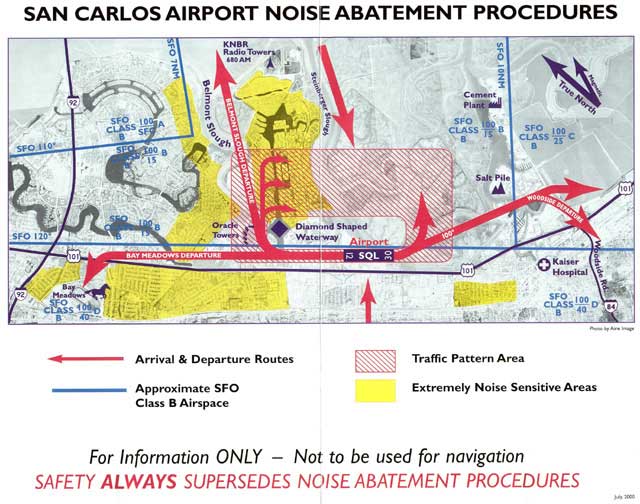The following email was sent to all our members on 3/24/17.
As I’m sure you all know, the Airport is surrounded by noise sensitive communities. The Voluntary Noise Abatement Procedures (VNAP), established more than 20 years ago, have been responsible for a peaceful and friendly relationship with our neighbors. To ensure that this continues, I wanted to send you this reminder and encourage you to send a copy of this email to anyone who might not be familiar with the VNAP.
Thank you for your continued support of SCAA. If you haven’t renewed your membership for 2017, please do so at our membership signup form. We need you now more than ever.
Sincerely,
Carol Ford, President
San Carlos Airport Association
Noise Abatement Procedures
San Carlos Airport is surrounded by noise sensitive areas. By using your aircraft’s quietest departure techniques and following the guidelines and procedures below, we can reduce the noise impact on our neighbors. The San Carlos Airport Pilots Association has adopted a Good-Neighbor-Policy and requests that resident and visitor aircraft comply with the voluntary noise abatement procedures described below.
Please Use Common Sense and Be Considerate to Airport Neighbors
- Reduce power/RPM as soon as safe and practical.**
- Avoid flying over homes in extremely noise sensitive areas.
- Departing traffic use Runway 12, wind permitting.
- Please consider the noise impact of your pattern flying activities. If able, fly after 10 a.m. on weekend and holiday mornings.
- No touch-and-goes when the Tower is not in operation.
- IFR departures: Give consideration to your noise impact.
- Helicopter operations: Contact airport office for procedures.
Most aircraft noise is generated by propeller tip noise. This is especially true when propeller tip speeds approach supersonic speeds. Even a small deduction of 100 or 200 RPM can produce a significant decrease in noise levels.
In addition, we ask your cooperation in restricting operations to:
On Weekdays: No touch-and go, low-approach or full stop-taxi back operations on Weekdays during the period from two (2) hours after sunset of one day and 8:00 a.m. of the following day, Monday through Friday; and until 9:30 a.m. on Saturday.
Sunset times are averaged on monthly basis for the purposes of these restrictions.
No touch-and-go, low approach, or taxi back operations Monday – Friday after:
January: 19:00 |
February: 19:30 |
March: 20:00 |
April: 21:30 |
May: 22:00 |
June: 22:30 |
July: 22:00 |
August: 22:00 |
September: 21:00 |
October: 20:30 |
November: 19:00 |
December: 19:00 |
On Weekends and Holidays: No touch-and go, low-approach or full stop-taxi back operations before 9:30 a.m. nor after 6:00 p.m. on any Saturday, Sunday or Holiday.
The San Carlos Airport Pilots Association has adopted a Good-Neighbor-Policy. That policy includes the following voluntary restriction: Pattern Work (repetitive circuits) is discouraged from 2300 hours until 0700 hours, daily. The Pilots Association requests that resident aircraft and visitors comply with this voluntary restriction.
For more information, comments or suggestions, please contact:
San Carlos Airport
620 Airport Drive, San Carlos, CA 94070
(650) 573-3700, FAX (650) 593-3762
Safety Always Supersedes Noise Abatement Procedures
PATTERN WORK (Runway 30)
Climb straight-out, parallel Highway 101. Fly your crosswind turn so that your ground track remains just northwest of the diamond-shaped waterway as depicted on the noise abatement map. (Do not overfly the diamond shaped waterway.) Delay your downwind turn until reaching 800 feet MSL and reducing power/RPM
PREFERRED DEPARTURES RUNWAY 30
Crosswind Departures: “Belmont Slough †Departure. Climb straight-out, parallel to Highway 101. Fly your crosswind turn so that your ground track remains just northwest of the diamond-shaped waterway as depicted on the noise abatement map. (Do not overfly the diamond shaped waterway.) Fly out the Belmont Slough. Avoid overflying homes on either side of the Slough. Caution: Remain northwest of KNBR radio towers to avoid inbound traffic (Stay clear of SFO Class B airspace).
Downwind Departures Delay your downwind turn until reaching 800 feet MSL. Continue climbing at reduced power/RPM setting until past housing. Make a 45 degree left turn off the downwind at pilot’s discretion or continue downwind. (Contact Palo Alto Tower prior to entering PAO Class D airspace.)
Woodside Departures: Delay your downwind turn until reaching 800 feet MSL. Continue climbing at reduced power/RPM setting until past housing. Proceed downwind until the Salt Pile prior to initiating a right turn.
Upwind Departures: “Bay Meadows†Departure. Climb straight-out, parallel Highway 101, until abeam the race track (6 DME from SFO VOR) then turn to a southwesterly heading, remaining south of Highway 92. (Stay Clear of SFO Class B airspace).
PREFERRED DEPARTURES RUNWAY 12
Aircraft departing Runway 12: turn left 20 degrees to a heading of 100 degrees as soon as is safe and after passing the end of the runway.
Southbound and Westbound: “Woodside†departure. Continue outbound on a heading of 100 degrees until past the Salt Pile prior to initiating a right turn. (Contact Palo Alto Tower prior to entering PAO Class D airspace.)Departures and Pattern Traffic: Begin your left crosswind turn as soon as traffic permits.
PREFERRED ARRIVALS:
(Use low noise setting inbound)
From North/Northwest (Runway 30): Make entry via the Steinberger Slough (southeast of KNBR radio towers). Caution: Traffic departing via Belmont Slough (3/4 mile northwest of radio towers).
From Southwest Through Northwest (Runway 30): Remain at least 1000 feet AGL. Make entry overhead the airport northeast bound. Cross overhead mid-field at or above 1200 feet MSL (Remain Below SFO Class B airspace). Caution: Traffic Pattern at 800 feet.
Straight-In Entry (Runway 30): Remain at or above 1000 feet MSL until passing Kaiser Hospital (Remain Below SFO Class B airspace).
Avoid aerobatic-style short approaches over the homes and buildings north of the airport.
Safety Always Supersedes Noise Abatement Procedures


